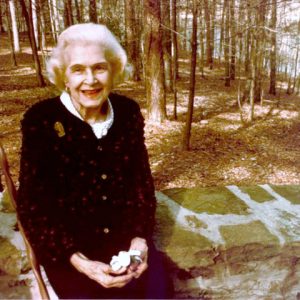calsfoundation@cals.org
Verna Cook Garvan (1911–1993)
Verna Mary Cook Garvan was one of the first women in Arkansas to own a construction/manufacturing business and was the benefactor of what is now Garvan Woodland Gardens in Hot Springs (Garland County).
Verna Cook was born on January 22, 1911, in Groveton, Texas, to Arthur Bacillius Cook and Essie Louise Bordis Cook. Verna Cook and her sister, Dorothy, were raised to be “proper ladies,” but Verna often accompanied her father to work and absorbed his business acumen. In 1916, her father moved the family to Malvern (Hot Spring County) to manage the Wisconsin and Arkansas Lumber Company, an enterprise producing oak and pine flooring. Malvern Brick and Tile was also purchased by Verna’s father, who later served as a board member of what is now the Malvern National Bank. His land and business investments were transferred upon his death to his wife and daughters but administered by Verna. At the end of her life, she was purported to have the largest holding of timber rights in Arkansas, as she always retained the mineral and timber rights from company land sales.
Cook grew up in Malvern but attended Holton-Arms, a prestigious Washington DC girls’ school, for her secondary education. When her father died in an auto accident on August 12, 1934, she was engaged to marry Alonzo Bernard Alexander of Spartanburg, South Carolina. Her mother and sister wished to take no active role in the family business, and after her marriage on October 1, 1934, she proposed that she and her husband manage the holdings. They moved to South Carolina, and Verna Alexander, who was in her mid-twenties, wanted to become a successful businesswoman at a time when women had just procured the right to vote.
Alexander’s marriage did not allow daily oversight of her Arkansas businesses, but they thrived nonetheless. Her business decisions had brought her family through the lean years of the Depression. The brick company provided the fire brick for reconstructed White House fireplaces and more than 30,000 bricks for the Army and Navy Hospital (now the Hot Springs Rehabilitation Center) in Hot Springs. She later built a show home in prestigious Hillsboro Beach, Florida, where she could nationally market her brick products in a climate she believed better suited her ailing son, Arthur Cook Alexander, born with cystic fibrosis. Arthur died in his late teens on November 29, 1954, and her first marriage ended soon after in 1956.
Verna moved permanently back to Arkansas and actively pursued her business interests. She became one of the first female chief executives in Arkansas. In the late 1950s, she met Francis Patrick Garvan Jr., son of a prominent New York City family who was visiting a friend in Hot Springs. They married on June 29, 1960, and lived in Hot Springs while planning a new home on the dual-peninsula, 210-acre property that is now the site of Garvan Woodland Gardens. She had been initially developing a garden there since about 1955 or 1956 and eventually planted hundreds of species of ornamental and native trees and shrubs. Her gardening interest had been forged early in life by the Malvern family’s African-American gardener.
When Patrick Garvan died unexpectedly in 1975, plans for the home were never realized. Verna Garvan sold her company to Acme Brick in the 1970s, and her efforts were afterward centered on her garden. Disappointed in her personal life, she sought to ensure that her garden would remain viable after her death.
In 1985, she bequeathed the first forty acres of her property to the Department of Landscape Architecture at the University of Arkansas (UA) in Fayetteville (Washington County), calling it Twentieth Century Gardens. She believed this woodland botanical garden could remain as a natural remnant in a century that had taken much from the earth. She maintained personal control of the garden, working with the department to catalog each plant species and its location until her October 1, 1993, death in Hot Springs from pancreatic cancer. She is buried in New York City’s Woodlawn Cemetery in the Garvan family mausoleum beside her second husband and her son Arthur.
Garvan’s endowment is directed by a trust to the University of Arkansas Foundation and the School of Architecture. Before her death, Garvan engaged renowned Arkansas architect E. Fay Jones to design her garden’s centerpiece, now known as the Verna Cook Garvan Pavilion. Its presence has inspired other landscape architecture and architecture garden commissions by notable Arkansans and their contemporaries. The garden has been partly funded by the state.
For additional information:
Brittenum, Judy Byrd. “Verna Cook Garvan: Time in a Garden.” Arkansas Historical Quarterly 70 (Spring 2011): 1–15.
Garvan Woodland Gardens. http://www.garvangardens.org (accessed January 25, 2023).
Parker, Suzi. “Benefactor of UA, Nature Lover Dies.” Arkansas Democrat-Gazette, October 4, 1993, p. 4B.
Verna Cook Garvan Papers. Department of Landscape Architecture. University of Arkansas at Fayetteville, Fayetteville, Arkansas.
Judy Byrd Brittenum
University of Arkansas, Fayetteville
 World War II through the Faubus Era, 1941 through 1967
World War II through the Faubus Era, 1941 through 1967 Verna Cook Garvan
Verna Cook Garvan 




Comments
No comments on this entry yet.